现代英国文学 Lesson 1-Historical Context-简版
- 格式:ppt
- 大小:497.50 KB
- 文档页数:8
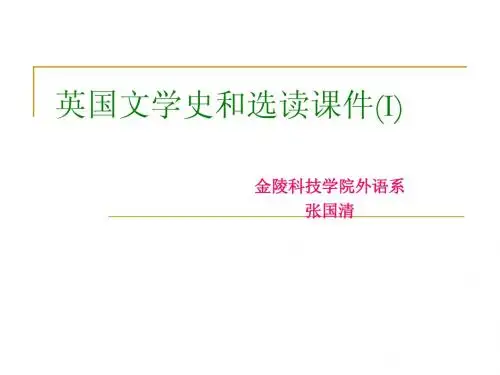
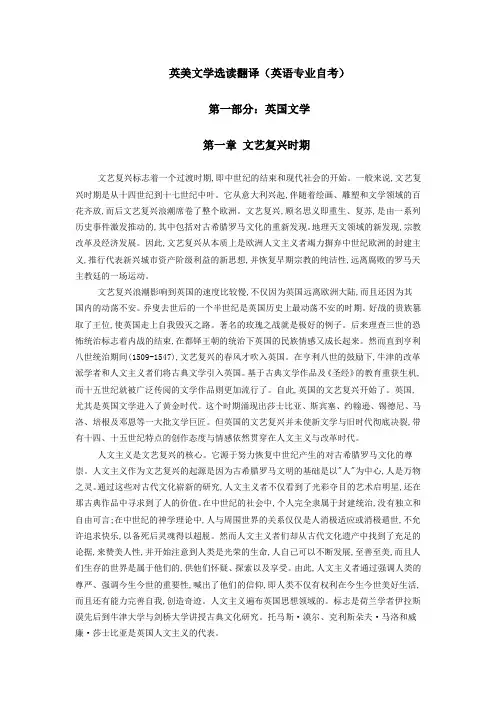
英美文学选读翻译(英语专业自考)第一部分:英国文学第一章文艺复兴时期文艺复兴标志着一个过渡时期,即中世纪的结束和现代社会的开始。
一般来说,文艺复兴时期是从十四世纪到十七世纪中叶。
它从意大利兴起,伴随着绘画、雕塑和文学领域的百花齐放,而后文艺复兴浪潮席卷了整个欧洲。
文艺复兴,顾名思义即重生、复苏,是由一系列历史事件激发推动的,其中包括对古希腊罗马文化的重新发现。
地理天文领域的新发现,宗教改革及经济发展。
因此,文艺复兴从本质上是欧洲人文主义者竭力摒弃中世纪欧洲的封建主义,推行代表新兴城市资产阶级利益的新思想,并恢复早期宗教的纯洁性,远离腐败的罗马天主教廷的一场运动。
文艺复兴浪潮影响到英国的速度比较慢,不仅因为英国远离欧洲大陆,而且还因为其国内的动荡不安。
乔叟去世后的一个半世纪是英国历史上最动荡不安的时期。
好战的贵族篡取了王位,使英国走上自我毁灭之路。
著名的玫瑰之战就是极好的例子。
后来理查三世的恐怖统治标志着内战的结束,在都铎王朝的统治下英国的民族情感又成长起来。
然而直到亨利八世统治期间(1509-1547),文艺复兴的春风才吹入英国。
在亨利八世的鼓励下,牛津的改革派学者和人文主义者们将古典文学引入英国。
基于古典文学作品及《圣经》的教育重获生机,而十五世纪就被广泛传阅的文学作品则更加流行了。
自此,英国的文艺复兴开始了。
英国,尤其是英国文学进入了黄金时代。
这个时期涌现出莎士比亚、斯宾塞、约翰逊、锡德尼、马洛、培根及邓恩等一大批文学巨匠。
但英国的文艺复兴并未使新文学与旧时代彻底决裂,带有十四、十五世纪特点的创作态度与情感依然贯穿在人文主义与改革时代。
人文主义是文艺复兴的核心。
它源于努力恢复中世纪产生的对古希腊罗马文化的尊崇。
人文主义作为文艺复兴的起源是因为古希腊罗马文明的基础是以"人"为中心,人是万物之灵。
通过这些对古代文化崭新的研究,人文主义者不仅看到了光彩夺目的艺术启明星,还在那古典作品中寻求到了人的价值。
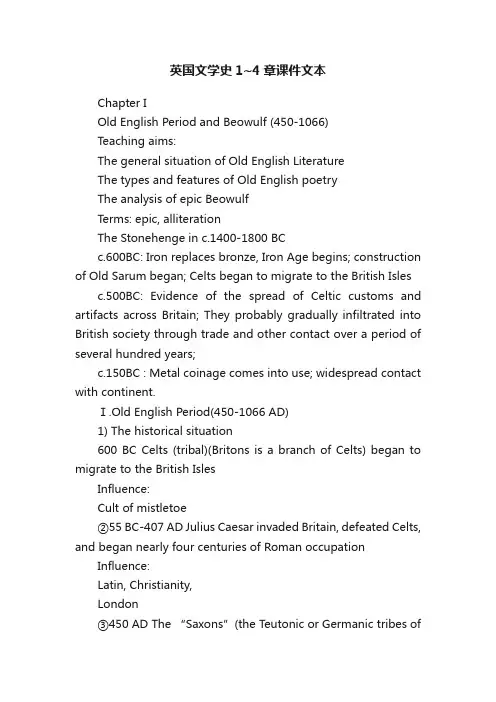
英国文学史1~4章课件文本Chapter IOld English Period and Beowulf (450-1066)Teaching aims:The general situation of Old English LiteratureThe types and features of Old English poetryThe analysis of epic BeowulfTerms: epic, alliterationThe Stonehenge in c.1400-1800 BCc.600BC: Iron replaces bronze, Iron Age begins; construction of Old Sarum began; Celts began to migrate to the British Islesc.500BC: Evidence of the spread of Celtic customs and artifacts across Britain; They probably gradually infiltrated into British society through trade and other contact over a period of several hundred years;c.150BC : Metal coinage comes into use; widespread contact with continent.Ⅰ.Old English Perio d(450-1066 AD)1) The historical situation600 BC Celts (tribal)(Britons is a branch of Celts) began to migrate to the British IslesInfluence:Cult of mistletoe②55 BC-407 AD Julius Caesar invaded Britain, defeated Celts, and began nearly four centuries of Roman occupation Influence:Latin, Christianity,London③450 AD The “Saxons”(the Teutonic or Germanic tribes ofAngles, Saxons, Jutes) ( originally seafaring people along the coast of Denmark and Germany)came to the British Isles and drove the Celts to Wales, Scotland and Ireland, and settle down themselves and named the central part of the island “England”, became the masters of England and the ancestors of the English people.Influence:ancestor④Late 8-9th century Viking (the Danes from Scandinavia ) invasions and be defeated by the Wessex King, Alfred the Great (849-c899)Influence:Little influence⑤1066 Norman (from Normandy in northern France) Conquest: William, Duke of Normandy, defeated Harold (the last Saxon king) in the battle of Hastings and became the King of England.Influence:Language, culture3.Chief literary achievements1)Pagan literature (Old English poetry in the form of oral sagas)(30,000 lines)Widsith: the first English poetMaldon: the last about a battle before 1000A.D.Beowulf: long epic poem2)Christian literature (writings developed with the teachings of the monks) (since the arrival of Saint Augustine in 597 AD.)◆(south) Roman influence : turn to saintly heroes◆(north) Celtic influence : lyric, subjective◆Anglo-Saxon achievements:(Northumbrian school of Celtic influence)Caedmon: the first religious poet, the father of English song, poetic paraphrase of the Bible)Venerable Bede: Father of English History, wrote The Ecclesiastical History of the English People《英吉利人民宗教史》?Cynewulf: the didactic poem The ChristKing Alfred the Great (848-901, ruled 871-899) :(1)translated a number of Latin books into West Saxon dialect.(2)wrote The Anglo-Saxon Chronicles《盎格鲁-撒克逊编年史》—the first and the best monument of the old English prose, which records the main happenings of Anglo-Saxon period.(3)created an Anglo- Saxon prose style which was not obscureⅡ. Beowulf1. Genre: national heroic epic2. Time: 8th century .3. Structure: 3182 lines in 2 parts.4. SignificanceIt is the oldest surviving epic poem, the primary work of English literature, and one of the four European heroic epics, with the other three being:The Song of Roland (French: La Chanson de Roland ),The Song of the Cid (Spanish:El Cantor de mio Cid ),The Lay of Igor's Host (Russian: СловоопълкуИгоревь)Term: EpicDefinition: a long narrative poemcelebrating the great deeds ofone or more legendary heroes ina grand ceremonious style.Example: Iliad, Odyssey5. Plot summary6. Artistic features1) Rhetorical devicesAlliterationKenningSimileParallelism2) Other featuresVarious in presentationComparisonMood: Solemn and animatedDescription: vigorous, picturesque and exactTerm: AlliterationDefinition: Alliteration is therepetition of initial sounds inneighboring words.Examples: sweet smell of successAnd sings a solitary songThat whistles in the wind.Term: KenningExcerpts:So the lord's men lived in joys,happily, until one beganto execute atrocities, a fiend in hell;en this ghastly demon was named Grendel,infamous stalker in the marches, he who held the moors, fen and desolate strong-hold; the land of marsh-monsters the wretched creature ruled for a timesince him the Creator had condemnedwith the kin of Cain; (Lines 99-107)That from home heard Hygelac's thane,a good man of the Geats, of Grendel's deeds;he was of mankind of the greatest strength,on that day in this life,noble and mighty; he ordered them a wave-crosser (sea-wood , foamy-necked floater )--a good one-- prepare; he said: the war-kingover swan-road (sea-street, water?s ridge)he wished to seek, that mighty clan-chief, since he was in need of men; (Lines94-201)--for him was the venture of Beowulf,brave seafarer's, a source of great displeasure,because he did not grant that any other manever glorious deeds the more on middle-earthheeded under the heavens than he himself--: (Lines 501-505)a bard sang from time to timeclear in Heorot; there was joy of heroes (Line 495)they praised his heroic deeds and his works of courage, exalted his majesty. As it is fitting,that one his friend and lord honours in words, cherish in one's spirit, when he must forth from his body be led; thus bemourned the people of the Geatstheir lord's fall, his hearth-companions:they said that he was, of all kings of the world,the most generous of men, and the most gracious,the most protective of his people, and the most eager for honour.(Lines 3173-3182)Chapter 2Middle English Period and Chaucer(1066-1485)I. Middle-English Period1. Historical Situation/doc/b72997598.html,nguage Development1. English became richer and more mature after absorbing French and Latin words .2. Old Anglo-Saxon flexions disappeared.3. After the wars, English language went through a process of unification. Changes occur in vocabulary, grammar and pronunciation. London dialect became the basis of new English, Middle English.3. Literary Achievements1)Romance3)Other genresPoem: Hymn, legend, visionDrama: Mystery play, miracle play, morality playProse: John Wycliff 约翰·威克里夫—Father of English prosetranslation of the BibleAllegory: William Langland?s The Vision of Piers Plowman威廉?兰格伦《农夫皮尔斯之幻象》●John WycliffThe Vision of Piers Plowman :A long middle English(14th century) alliterative allegorical poem with a complex variety of religious themes. One of the major achievements of Piers Plowman is that it translates the language and conceptions of the cloister into symbols and images that could be understood by the layman.Term: Romance传奇A fictional story in verse or prose that relates improbableadventures of idealized characters in some remote or enchanted setting.Term: Ballad民谣A folksong or orally transmitted poem telling in a direct and dramatic manner some popular story usually derived from a tragic incident in local history or legend. The story is told simply, impersonally and often with vivid dialogue and often in quatrains with alternating four-stress and three-stress lines, the second and fourth lines rhyming.II. Geoffrey Chaucer (c. 1343-1400)Contributions●Father of English literature●Father of English poetry (a great narrative poet)●The greatest poet of the Middle Ages●The first writer of humanistic concern●Creator of Middle English by using London dialect●The first poet to have been buried in Poet?s Corner of Westminster Abbey Being the first realistic writerLife and Literary CareerDant?Alighieri●the Supreme Poet●Father of the Italian language●The first of “the three fountains” or “the three crowns”: The Divine Comedy 《神曲》●The greatest and the masterpiece of Italian language.●A culmination of the medieval world view.●Be of humanistic concerns.●He influenced all the later western literary writers.Giovanni Boccaccio薄迦邱●The third of the Three Crowns of Italian literature;●The great master and model of classic Italian prose;●The greatest of modern story-tellers.Decameron 《迪卡麦伦十日谈》●A frame story encompassing 100 tales by ten young people.●The bawdy tales of love range from the erotic to the tragic.●Tales of wit, practic al jokes, and life lessons contribute to the mosaic.●It documents the life in 14 century Italy.Book of the Duchess《公爵夫人之书》●Genre: elegy in a dream vision●The earliest of Chaucer?s poems;●The book is intended to lament the death of Blanche, the Duchess, an d to console her husband, and Chaucer?s patron, John the Duke.●In the poem, he dreamed a man in black and grief. He shared the man?s grief and helped him out of the sorrow.Term: elegy哀歌,哀悼诗●A song or poem of mourning, pervaded by a tone of deep melancholyThe House of Fame 《声誉之宫》●A poem of over 2000 lines in dream vision.●Upon falling asleep the poet finds himself in a glass temple adorned with images of the famous and their deeds. With an eagle as a guide, he meditates on the nature of fame and the trustworthiness of recorded renown. This allows Geoffrey to contemplate the role of the poet in reporting the lives of the famous and how much truth there is in what can be told.The Legend of Good Women《贤妇传说》●A poem in a dream vision form.●The third longest after The Canterbury Tales and Troilus andCriseyde.●The first significant to use the iambic pentameter●The poet recounts ten stories of virtuous women in nice sections.The Parliament of Fowls《百鸟会议》●Approximately 700 lines.●In the form of a dream vision●First refer to the idea that St. Valentine?s Day was a special day of lovers.Troilus and Criseyde《特罗伊拉斯和克莱西得》●A finished long poem●Set against the Siege of Troy.●Regarded by some as the finest byChaucer.Term: AllegoryIt is a story or description in which the abstract qualities or ideas, such as patience, purity, or truth, are personified as characters in the story so the characters and events symbolize some deeper underlying meaning, and serve to spread moral teaching.2.The Canterbury T ales (1386-1400)1) Structure:2) Artistic FeaturesTerm: Heroic couplet英雄双韵体It is a rhymed couplet of iambic pentameter lines. It was established by Chaucer as a major English verse-form for narrative and other kinds of non-dramatic poetry.Term: iambic pentameter 五步抑扬格A metrical verse line having five main stresses, or a line of five feet and 10 syllables, with every foot (basic metrical unit)comprising 2 syllables, one unstressed followed by one stressed.Characters:●A colorful gallery of 29 pilgrim s who cover a great range of social life.●They include a knight, a squire, a prioress, a friar, a merchant,a clerk, a sergeant of the law, a Franklin, a doctor, the wife of Bath,a plowman, a miller, a summoner, a pardoner, and so on.●Chaucer and the in n host joined them, the inn host acting as the judge about the best story-teller.Themes:●It presents a picturesque panorama of his contemporary England and shows his realistic tendency, subtle irony and freedom of views.●He believes in the right of man to earthly happiness and opposes superstitions and a blind belief in fate. He praises man?s energy, intellect, quick wit and the love for life and mocks at the Roman Catholic authorities who exploit the English people.●He is the avant-garde of the Age of Renaissance.The Prologue●When the sweet showers of April fall and shoot●Down through the drought of March to pierce the root,●…●And the small fowls are making melody●That sleep away the night with open eye●…●In Southwark, at The Tabard, as I lay●Ready to go on pilgrimage and start●For Canterbury, most devout at heart,●At night there came into that hostelry●Some nine and twenty in a company●And promised to rise early and take the way ●To Canterbury, as you heard me say●But none the less, whil e I have time and space, ●Before my story takes a further pace,●It seems a reasonable thing to say●What their condition was, the full arrayOf each of them, as it appeared to me, According to profession and degree,And what apparel they were riding in;And at a Knight I therefore will begin.…There also was a Nun, a Prioress;Simple her way of smiling was and coy.Her greatest oath was only “By St Loy!”And she was known as Madam Eglantyne.And when she sang a service, with a fine Intoning through her nose, as was most seemly, And she spoke daintily in French, extremely, After the school of Stratford-atte-Bowe; French in the Paris style she did not know.At meat her manners were all taught withal; No morsel from her lips did she let fall,Nor dipped her fingers in the sauce too deep; But she could carry a morsel up and keepThe smallest drop from falling on her breast. For courtliness she had s special zest.And she would wipe her upper lip so clean That not a trace of grease was to be seen Upon the cup when she had drunk; to eat,Se reached a hand sedately for the meat.She certainly was very entertaining,Pleasant and friendly in her ways, and straining To counterfeit a courtly kind of grace,A stately bearing fitting to her place,And to seem dignified in all her dealings.As for her sympathies and tender feelings,She was so charitably solicitousShe used to weep if she but saw a mouse Caught in a trap, if it were dead or bleeding. And she had little dogs she would be feeding With roasted flesh, or milk, or fine white bread. Sorely she wept if one of them were deadOr someone took a stick and made it smart;She was all sentiment and tender heart.Her veil was gathered in a seemly wayHer nose was elegant, her eyes glass-gray;Her mouth was very small, but soft and red,And certainly she had a well-shaped head Almost a span across the brows, I own;She was indeed by no means undergrown.Her cloak, I noticed, had graceful charm.She wore a coral trinket on a her arm,A set of beads, the gaudies tricked in green Whence hung a golden brooch of brightest sheen On which there first was graven a crowned A, And lower, Amor vincit omnia.Her cloak, I noticed, had graceful charm.She wore a coral trinket on a her arm,A set of beads, the gaudies tricked in greenWhence hung a golden brooch of brightest sheenOn which there first was graven a crowned A,And lower, Amor vincit omnia.Term: Irony●The use of words to express something other than or opposite of the literary meaning, and also a humourous or sardonic literary style or form characterised by irony.Term: satire●A mode of writing that eposes the failings of individuals, institutions, or societies to ridicule and scorn.Term: frame(d) story/ frame(d) narrative●A story in which another story is enclosed or embedded asa tale within a tale, or which contains several such tales●E.g. Boccaccio?s Decameron(1353) and Chaucer?s The Canterbury Tales(c. 1390) and Emily Bront??s Wuthering Heights, and Mary Shelley?s Frankenstein.Chapter 3English Renaissance Literature(1485-1616)Tudor, House of (1458-1603)an English dynasty descended from Owen Tudor; Tudor monarchs ruled from Henry VII to Elizabeth I (from 1485 to 1603 ) English RenaissanceHenry VIIIElizabeth I (1558-1603)Humanism1)Thomas More (1478-1535)2)Edmund SpencerLifeWorksThe Shepheardes Calender (1579)《牧人日记》pastoral poem of 12 parts,set the pastoral fashion, ushered in lyrical poetryThe Faerie Queene (1596)《仙后》allegorical romance in verse,Spenserian stanza: stanza of 9 lines in iambic pentameter, the ninth an alexandrine with 6 iambic feet, rhyming scheme is ababbcbcc.Term: Pastoral poemDefinition:A highly conventional mode of poem form that celebrates the innocent life of shepherds and shepherdesses.Pastoral literature describes the loves and sorrows of musical shepherds, usually in an idealized rustic innocence and idleness; paradoxically, it is an elaborately artificial cult of simplicity and virtuous frugality.3)Philip SidneyLifeWorksA Defence of Poesy《诗辩》The Arcadia 《阿卡迪亚》University Wits4)John Lyly5)Thomas Lodge6)Thomas Nashe7)Robert Greene8)Francis Bacon (1561-1626)9)Christopher Marlowe (1564-1593)Term: Blank VerseDefinition:Unrhymed lines of iambic pentameter.10) Ben JonsonLife and SignificanceContemporary of ShakespeareThe first poet Laureate“sons of Ben”“O rare Ben Jonson”Comedy of HumoursWorksEvery Man in His Humour (1598) )《人各有癖》Every Man out of His Humour (1599)《人各无癖》Volpone(1606)《狐狸》The Alchemist (1610)《炼金术士》Term: Three UnitiesDefinition:In the 1500s and 1600s, critics of drama expanded Aristotle?s ideas in the Poetics to create the rule of the "three unities." A good play, according to this doctrine, must have three traits. The first is unity of action (realistic events following a single plotline and a limited number of characters . The second is unity of time, meaning that the events should be limited to the two or three hours it takes to view the play, or at most to a single day of twelve or twenty-four hours compressed into those two or three hours. The third is unity of space, meaning the play must take place in a single setting or location.Term: HumorDefinition:The bodily fluids to which medieval medicine attributed the various types of human temperament, according to the predominance of each within the body.The comedy of humors, best exemplified by Ben Jonson?sEvery Man in His Humor, is based on the eccentricities of characters whose temperaments are distorted in ways similar to an imbalance among the bodily humours.DanteDa VinciMultiple ChoiceTo be continued…Blank FillingTo be continued…Chapter 4William Shakespeare(1564-1616)Life and Literary CareerKing Edward VI Grammar School at StratfordShakespeare?s HomeLiterary ProductionsHe authored altogether 37 plays and154 sonnets, which were created in 3 phases generally.I. Apprenticeship and growth: History plays and comedies ( 1590-1600)II. Gloom and depression: Tragedies (1601-1608)III. Restored serenity: Dramatic romances (1609-1612)Artistic Features●Represented the t rend of history in giving voice to the desires and aspirations of the people.●Reflected the humanist spirit of his age.●Was most successful in characterization.●Instilled into old materials a new spirit that gives new life to his plays●Was good at poem writing, which were rich in images,conceit, metaphors and symbols.●Was a master of the English language.Contributions●Break the strict drama principle of three unities.●Breaks the division between tragedy and comedy and creates realistic plays that have both tragic and comic elements.History Plays●Richard III●Henry IV (most significant one)●Henry V (Prince Hal, ideal monarch)●Henry VI●Julius Caesar (about Roman history)Comedies●A Mid-Summer Night’s Dream●As You Like It●The Twelfth Night (most careful plotted)(Problem plays)●Measure for Measure●The Merchant of VeniceThe Merchant of Venice●Theme: To praise the gallant friendship and the good gentleman in Antonio and reveal the miserable conditions of the Jews in a Christian world.●Que stions for discussion:What humanist values are demonstrated in this work?What is Shakespeare?s attitude towards money?●Antonio: I know not why I am so sad: It wearies me; you say it wearies me. But how I caught it, found it; or came by it. What stuff it is made of, whereof it is born, I am to learn, such a want wit sadness makes of me, that I have much ado to know myself.●Salarino: Your mind is tossing on the ocean,…and every object that might make me fear misfortune to my ventures, out of doubt would make me sad.Tragedies●Hamlet《哈姆雷特》●King Lear《李尔王》●Macbeth《麦克白》●Othello《奥赛罗》Tragicomedy 悲喜剧●A kind of drama representing some action in which serious and comic scenes are blended; a composition partaking of the nature both of tragedy and comedy.Term:Farce 闹剧●A light dramatic work in which highly improbable plot situations, exaggerated characters, and often slapstick elements are used for humorous effect.Hamlet《哈姆雷特》●A revenge story similar to Thomas Kyd?s The Spanish Tragedy.●Expressed the noble q uality of Prince Hamlet as a representative of humanist philosophical thinkers and his disillusionment with the corrupt and degenerated society in which he lived, as well as the humanistic search for the value of man and the disappointment of such ideals.Act IIIScene 1●HAMLETTo be, or not to be: that is the question,Whether?tis nobler in the mind to sufferThe slings and arrows of outrageous fortune,Or to take arms against a sea of troubles,And by opposing end them. To die, to sleep;No more; and by a sleep to say we endThe heartache, and the thousand natural shocks That flesh is heir to, …tis a consummation●Devoutly to be wished. To die, to sleep.●To sleep, perchance to dream; ay, there?s the rub;●For in that sleep of death what dreams may come ●When we have shuffled off this mortal coil,●Must give us pause. There?s the respect●That makes calamity of so long life●For who would bear the whips and scorns of time,●Th?oppressor?s wrong, the proud man?s contumely,●The pangs of despised love,the la w?s delay,●The insolence of office, and the spurns●That patient merit of th?unworthy takes,●When he himself might his quietus make●With a bare bodkin? who would fardels bear,To grunt and sweat under a weary life,But that the dread of something after death,The undiscover'd country from whose bourn●No traveller returns, puzzles the willAnd makes us rather bear those ills we haveThan fly to others that we know not of?Thus conscience does make cowards of us all;And thus the native hue of resolutionIs sicklied o'er with the pale cast of thought,And enterprises of great pith and momentWith this regard their currents turn awry,And lose the name of action.The romantic drama传奇剧●the kind of drama whose aim is to present a tale or history in scenes, and whose plays (like those of Shakespeare, Marlowe, and others) are stories told in dialogue by actors on the stage.Dramatic Romances●Pericles《培里克利斯》●Cymbeline《辛白林》●The Winter’s Tale《冬天的故事》●The Tempest《暴风雨》Significance: No malice or bloody conflicts, demonstrate author?s good will for mankind and the wish for a peaceful and harmonious human world in allegorical or fairy-tale romances.Soliloquy戏剧独白●A dramatic speech uttered by one character speaking aloud while alone on the stage or while under the impression of being alone to reveal his or her inner thoughts and feelings to the audience.Shakespearean Sonnets●Contents●StructureSonnet 18To be continued…To be continued…To be c ontinued…。
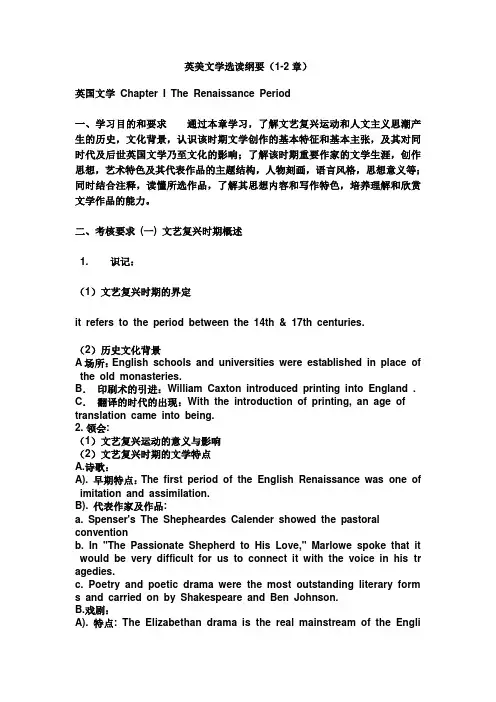
英美文学选读纲要(1-2章)英国文学Chapter I The Renaissance Period一、学习目的和要求通过本章学习,了解文艺复兴运动和人文主义思潮产生的历史,文化背景,认识该时期文学创作的基本特征和基本主张,及其对同时代及后世英国文学乃至文化的影响;了解该时期重要作家的文学生涯,创作思想,艺术特色及其代表作品的主题结构,人物刻画,语言风格,思想意义等;同时结合注释,读懂所选作品,了解其思想内容和写作特色,培养理解和欣赏文学作品的能力。
二、考核要求(一) 文艺复兴时期概述1. 识记:(1)文艺复兴时期的界定it refers to the period between the 14th & 17th centuries.(2)历史文化背景A场所:English schools and universities were established in place of the old monasteries.B.印刷术的引进:William Caxton introduced printing into England . C.翻译的时代的出现:With the introduction of printing, an age of translation came into being.2. 领会:(1)文艺复兴运动的意义与影响(2)文艺复兴时期的文学特点A.诗歌:A). 早期特点:The first period of the English Renaissance was one of imitation and assimilation.B). 代表作家及作品:a. Spenser's The Shepheardes Calender showed the pastoral conventionb. In "The Passionate Shepherd to His Love," Marlowe spoke that it would be very difficult for us to connect it with the voice in his tr agedies.c. Poetry and poetic drama were the most outstanding literary form s and carried on by Shakespeare and Ben Johnson.B.戏剧:A). 特点: The Elizabethan drama is the real mainstream of the English RenaissanceB). 作家: The most famous dramatists are Christopher Marlowe, Willi am Shakespeare, and Ben Johnson.(3)人文主义的主张及对文学的影响3. 应用:文艺复兴,人文主义及玄学诗等名词的解释Definitions of the Literary Terms:1.Iambic pentameter 五音步抑扬格is the most common English meter, in which each foot contains an unaccented syllable and an accented syllable.2.Blank verse无韵体诗is the unrhymed iambic pentameter line. It was Surrey who first brought it in and Marlowe perfected it with his “mighty lines”and made it the principle medium of English drama.3.Heroic couplet英雄双行体两行押韵的抑扬格五音步a couplet in iambic pentameter4.Sonnet is a poem of 14 lines, usually in iambic pentameter, restricted to a definite rhyme scheme.There are two prominent types:1) Shakespearean sonnet, or the Elizabethan sonnet, consisting of three quatrains and a couplet (rhyming abab cdcd efef gg)2) Italian/Petrarchan sonnet, composed of 2 quatrains and a sestet (rhyming abba abba cdecde)Sestet: a 6-line unit1. The Renaissance: The Renaissance marks a transition from the medieval to the modern world. Generally, it refers to the period bet ween the 14th & 17th centuries. It first started in Italy, with the flow ering of painting, sculpture & literature. From Italy the movement w ent to embrace the rest of Europe. The Renaissance, which means "rebirth" or "revival," is actually a movement stimulated by a series of historical events, such as the re-discovery of ancient Roman & Greek culture, the new discoveries in geography & astrology, the rel igious reformation & the economic expansion. The Renaissance, the refore, in essence is a historical period in which the European hum anist thinkers & scholars made attempts to get rid of those old feu dalist ideas in medieval Europe, to introduce new ideas that expres sed the interests of the rising bourgeoisie, & to recover the purity of the early church from the corruption of the Roman Catholic Chur ch.Humanism: Humanism is the essence of the Renaissance. Humanism is a system of beliefs upheld by writers and artists of the Renaissance period in their fighting against medieval asceticism ( [ə'setisizəm] 禁欲主义)。
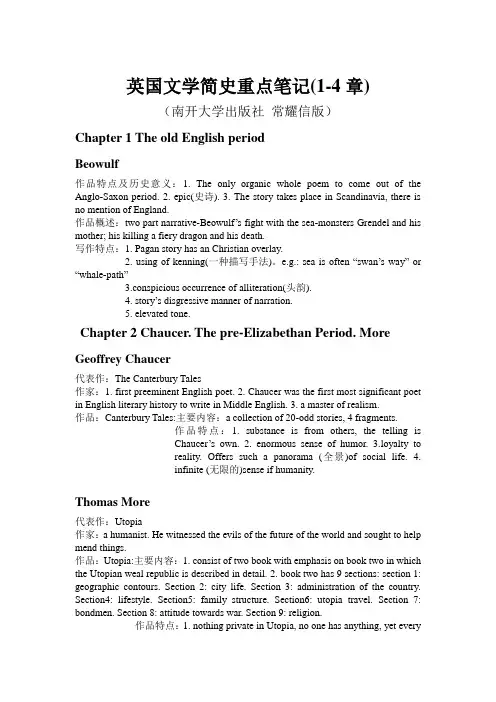
英国文学简史重点笔记(1-4章)(南开大学出版社常耀信版)Chapter 1 The old English periodBeowulf作品特点及历史意义:1. The only organic whole poem to come out of the Anglo-Saxon period. 2. epic(史诗). 3. The story takes place in Scandinavia, there is no mention of England.作品概述:two part narrative-Beowulf’s fight with the sea-monsters Grendel and his mother; his killing a fiery dragon and his death.写作特点:1. Pagan story has an Christian overlay.2. using of kenning(一种描写手法)。
e.g.: sea is often “swan’s way” or “whale-path”3.conspicious occurrence of alliteration(头韵).4. story’s disgressive manner of narration.5. elevated tone.Chapter 2 Chaucer. The pre-Elizabethan Period. More Geoffrey Chaucer代表作:The Canterbury Tales作家:1. first preeminent English poet. 2. Chaucer was the first most significant poet in English literary history to write in Middle English. 3. a master of realism.作品:Canterbury Tales:主要内容:a collection of 20-odd stories, 4 fragments.作品特点:1. substance is from others, the telling isChaucer’s own. 2. enormous sense of humor. 3.loyalty toreality. Offers such a panorama (全景)of social life. 4.infinite (无限的)sense if humanity.Thomas More代表作:Utopia作家:a humanist. He witnessed the evils of the future of the world and sought to help mend things.作品:Utopia:主要内容:1. consist of two book with emphasis on book two in which the Utopian weal republic is described in detail. 2. book two has 9 sections: section 1: geographic contours. Section 2: city life. Section 3: administration of the country. Section4: lifestyle. Section5: family structure. Section6: utopia travel. Section 7: bondmen. Section 8: attitude towards war. Section 9: religion.作品特点:1. nothing private in Utopia, no one has anything, yet everyis rich. Offers best ideal social system possible. 2. someproblems: strict adherence to conformity; slave system; superpower politics; male-dominated.Chapter 3 The Elizabethan Age. Spenser. Sidney. Marlowe Edmund Spenser代表作:The Faerie Queene; The Shepheardes Calendar.作家:a non-dramatic poet; of Queen Elizabeth’s period; read and loved Chaucer andsaw him as his pattern in literary creation.作品:The Shepheardes Calendar: 主要内容:1. consists of 12 pastoral eclogues(田园牧歌),one for each month of the year. 2. Dialoguesbetween shepherds or of soliloquies, the everyday life ofcountry people, their feelings and attitudes, and their simplelife of harmony with nature. 3. around with suchobservations on the religious strife and political turbulence ofhis day.作品特点:1. full of archaic(古代的) or“Chaucerian” words, bring into relief a rustic(乡村的,纯朴的)effect.2. The eclogues in the Calendarfall into three groups-plaintive, recreative, and moral.The Faerie Queene: 主要内容:1. praise of ElizabethⅠ’s England in itself.2. Consistent of six books and a fragment of the seventhbook. 3. tell respectively about the Red Cross Knight ofHoliness, the Knight of Temperance, the legend of chastity,that of friendship, the Knight of Justice, and the Knight ofCourtesy.作品特点:1. Courageous experimentation with themeters. Special rhyme scheme of the Spenserian sonnets ,and in the Spenserian stanza.Marlowe代表作:The Tragical History of Doctor Faustus; The Jew of Malta作家:The most preeminent figure among the University wits.作品:The Tragical History of Doctor Faustus: 主要内容:1. first part of the play tellsof Faustus’s dissatisfactionwith earthly knowledge and of hispart with the devil.2. second part about his satisfaction withhis newly acquired knowledge and power. 3.The third partsoul being dragged down to hell, tries to pray to God’s save.作品特点:1. famous both for itsthematic and formal features. 2. Thematically, Faustusrepresents the archetypal Renaissance humanist of 16thcentury, and a supreme specimen of Everyman for all time.3.Formally, uses some dramatic devices like the choruses.Chapter4Shakespeare主要作品:sonnets, Romeo and Juliet, A Midsummer Night’s Dream, The Merchantof Venice, As You Like It, Julius Caesar, Hamlet, Othello,King Lear, Macbeth作品:sonnets: 154 in totalTheme: 1. love, passion, and sparks of wisdom. 2.clear vision of lifeand people. 3. Renaissance paean of man. 4. a faithful recordof the mood and tenor of the times.Style: grace in form, depth in thought, and vivacity in tone.Plays: first period: generally happy and cheerful. All dramas this period endhappily.Second period: frustration, tragic period. All his major tragedies werewritten within the space of a few years.Last period: acceptance of the inevitability of life.特点:1. highly moral. Evil be punished and good rewarded.2. wisdom and profound philosophy.3. tolerant of human foibles and faults4. avoids the use of just one color-pure black or white5. comic element alongside the serious.6. sense of individual worth.7. borrows from existing works but revises and makes themsubstantially and superior.Bacon代表作品:Essays作品特点:wisdom and his unique style.Intimate knowledge of human nature。
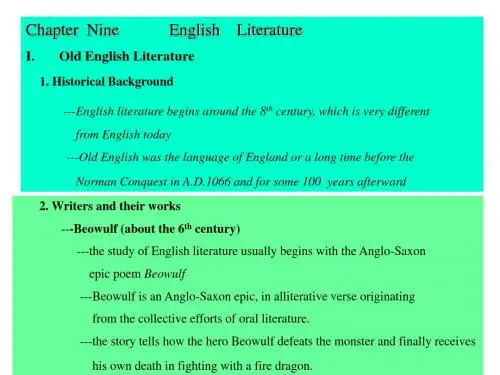
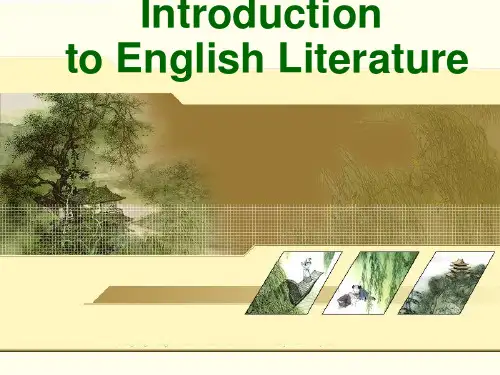
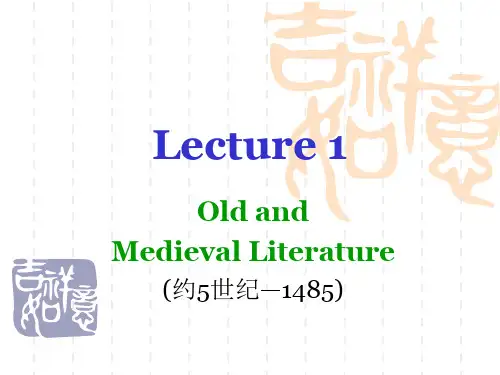
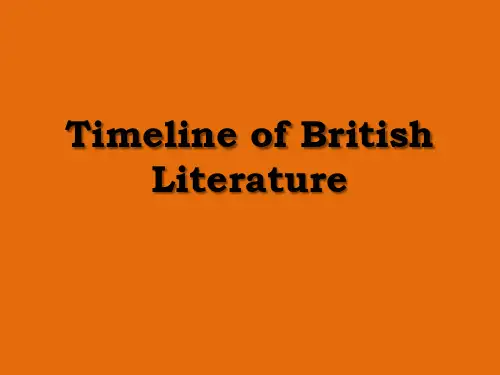

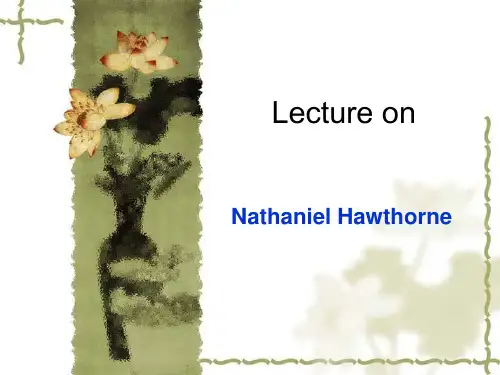
英国文学第一章,早期英国文学和中世纪英国文学1 我们所说的英格兰是一个岛屿,早期的居民是大不列颠人,他们是凯尔特Celts的一个部落。
公元前55年,罗马征服者裘力斯.凯撒Julius Caesar侵入英国,直到公元78年完全征服英国。
在罗马军队撤出后,成群的海盗侵入大不列颠,他们是北欧的三个部族,盎格鲁人,撒克逊人和朱特人,分别建成一些小国家,到公元7世纪,这些小王国合并成了一个联合王国成为英格兰或者盎格鲁王国,这3个部族形成了一个英国民族,其中盎格鲁人最多。
他们所说的三种方言自然发展形成了一种统一的语言成为盎格鲁.撒克逊语,或古英语。
盎格鲁撒克逊时期见证了英国从部落社会向封建制度的转变。
盎格鲁撒克逊人是异教徒,他们相信古老的北欧神话,在公元七世纪时被基督教同化,2 《贝奥武夫》BeowulfBeowulf是一个传说它主要的故事明显是北部原始部落的民间传说。
Beowulf是一个伟大的英雄,尽管这首诗写于10世纪,其英雄主要还是大陆原始部落社会的产物。
恩格斯指出,它反映了古代时期部落社会的特点。
在形式上最突出的特点是头韵的运用。
其他的特点是隐喻和保守陈述的使用。
3 大约在787年,一伙丹麦海盗侵入英国阿尔弗德雷王King Alfred The great 成功用武力把他们驱逐了出去,然而在他死后,丹麦人在1013年占领了这个国家,并统治了30年,威廉公爵领导下的诺曼人讲法语,他们于1066年来到英国,他们残酷地镇压了起义,用武力完成了征服,即诺曼底征服。
诺曼底征服标志着封建主义在英国的建立。
4 威廉.朗兰William Langland中世纪的文学领域几乎是一片空白,但确实有一片作品表明当时英语流行文学的存在,即《耕者皮休斯》Piers the Plowman 这首诗描写了一系列的梦境,通过这些梦境我们可以看到一幅封建英国的图景。
Piers the Plowman是英国最伟大的诗篇之一,他以梦幻的形式被书写出来,这是中世纪文学一个常见的方法,这首诗也是一篇寓言,利用了象征的手法讲述真理,5 罗宾汉的民谣收集在《罗宾汉传奇》的集子中,描述了英雄的整个生活。
英国文学简史完全笔记A Concise History of British LiteratureChapter 1 English Literature of Anglo-Saxon PeriodI.Introduction1. The historical background(1)Before the Germanic invasion(2)During the Germanic invasiona. immigration;b. Christianity;c. heptarchy.d. social classes structure: hide-hundred; eoldermen (lord)– thane - middle class (freemen)- lower class (slave or bondmen: theow);e. social organization: clan or tribes.f. military Organization;g. Church function: spirit, civil service, education;h. economy: coins, trade, slavery;i. feasts and festival: Halloween, Easter; j. legal system.2. The Overview of the culture(1)The mixture of pagan and Christian spirit.(2)Literature: a. poetry: two types; b. prose: two figures.II.Beowulf.1. A general introduction.2. The content.3. The literary features.(1)the use of alliteration(2)the use of metaphors and understatements(3)the mixture of pagan and Christian elementsIII.The Old English Prose1.What is prose?2.figures(1)The V enerable Bede(2)Alfred the GreatChapter 2 English Literature of the Late Medieval Ages I.Introduction1. The Historical Background.(1)The year 1066: Norman Conquest.(2)The social situations soon after the conquest.A. Norman nobles and serfs;B. restoration of the church.(3)The 11th century.A. the crusade and knights.B. dominance of French and Latin;(4)The 12th century.A. the centralized government;B. kings and the church (Henry II and Thomas);(5)The 13th century.A. The legend of Robin Hood;B. Magna Carta (1215);C. the beginning of the ParliamentD. English and Latin: official languages (the end)(6)The 14th century.a. the House of Lords and the House of Commons—conflict between the Parliament and Kings;b. the rise of towns.c. the change of Church.d. the role of women.e. the Hundred Years' War—starting.f. the development of the trade: London.g. the Black Death.h. the Peasants' Revolt—1381.i. The translation of Bible by Wycliff.(7)The 15th century.a. The Peasants Revolt (1453)b. The War of Roses between Lancasters and Yorks.c. the printing-press—William Caxton.d. the starting of Tudor Monarchy(1485)2. The Overview of Literature.(1)the stories from the Celtic lands of Wales and Brittany—great myths of the Middle Ages. (2)Geoffrye of Monmouth—Historia Regum Britanniae—King Authur.(3)Wace—Le Roman de Brut.(4)The romance.(5)the second half of the 14th century: Langland, Gawin poet, Chaucer.II.Sir Gawin and Green Knight.1. a general introduction.2. the plot.III.William Langland.1. Life2. Piers the PlowmanIV.Chaucer1. Life2. Literary Career: three periods(1)French period(2)Italian period(3)master period3. The Canterbury TalesA. The Framework;B. The General Prologue;C. The Tale Proper.4. His Contribution.(1)He introduced from France the rhymed stanza of various types.(2)He is the first great poet who wrote in the current English language.(3)The spoken English of the time consisted of several dialects, and Chaucer did much in making the dialect of London the standard for the modern English speech.V. Popular Ballads.VI.Thomas Malory and English ProseVII.The beginning of English Drama.1. Miracle Plays.Miracle play or mystery play is a form of medieval drama that came from dramatization of the liturgy of the Roman Catholic Church. It developed from the 10th to the 16th century, reaching its height in the 15th century. The simple lyric character of the early texts was enlarged by the addition of dialogue and dramatic action. Eventually the performance was moved to the churchyard and the marketplace.2. Morality Plays.A morality play is a play enforcing a moral truth or lesson by means of the speech and action of characters which are personified abstractions – figures representing vices and virtues, qualities of the human mind, or abstract conceptions in general.3. Interlude.The interlude, which grew out of the morality, was intended, as its name implies, to be used more as a filler than as the main part of an entertainment. As its best it was short, witty, simple in plot, suited for the diversion of guests at a banquet, or for the relaxation of the audience between the divisions of a serious play. It was essentially an indoors performance, and generally of an aristocratic nature.英国文学简史完全笔记2007-7-2713:56页面功能【字体:大中小】【打印】【关闭】Chapter 3 English Literature in the Renaissance I.A Historical BackgroundII.The Overview of the Literature (1485-1660)Printing press—readership—growth of middle class—trade-education for laypeople-centralization of power-intellectual life-exploration-new impetus and direction of literature.Humanism-study of the literature of classical antiquity and reformed education.Literary style-modeled on the ancients.The effect of humanism-the dissemination of the cultivated, clear, and sensible attitude of its classically educated adherents.1. poetryThe first tendency by Sidney and Spenser: ornate, florid, highly figured style.The second tendency by Donne: metaphysical style—complexity and ingenuity.The third tendency by Johnson: reaction——Classically pure and restrained style.The fourth tendency by Milton: central Christian and Biblical tradition.2. Dramaa. the native tradition and classical examples.b. the drama stands highest in popular estimation: Marlowe – Shakespeare – Jonson.3. Prosea. translation of Bible;b. More;c. Bacon.II.English poetry.1. Sir Thomas Wyatt and Henry Howard (courtly makers)(1)Wyatt: introducing sonnets.(2)Howard: introducing sonnets and writing the first blank verse.2. Sir Philip Sidney—poet, critic, prose writer(1)Life:a. English gentleman;b. brilliant and fascinating personality;c. courtier.(2)worksa. Arcadia: pastoral romance;b. Astrophel and Stella (108): sonnet sequence to Penelope Dvereux—platonic devotion. Petrarchan conceits and original feelings-moving to creativeness—building of a narrative story; theme-love originality-act of writing.c. Defense of Poesy: an apology for imaginative literature—beginning of literary criticism.3. Edmund Spenser(1)life: Cambridge - Sidney's friend - “Areopagus” – Ireland - Westminster Abbey.(2)worksa. The Shepherds Calendar: the budding of English poetry in Renaissance.b. Amoretti and Epithalamion: sonnet sequencec. Faerie Queene:l The general end——A romantic and allegorical epic—steps to virtue.l 12 books and 12 virtues: Holiness, temperance, justice and courtesy.l Two-level function: part of the story and part of allegory (symbolic meaning)l Many allusions to classical writers.l Themes: puritanism, nationalism, humanism and Renaissance Neoclassicism—a Christian humanist. (3)Spenserian Stanza.III.English Prose1. Thomas More(1)Life: “Renaissance man”, scholar, statesman, theorist, prose writer, diplomat, patron of artsa. learned Greek at Canterbury College, Oxford;b. studies law at Lincoln Inn;c. Lord Chancellor;d. beheaded.(2)Utopia: the first English science fiction.Written in Latin, two parts, the second—place of nowhere.A philosophical mariner (Raphael Hythloday)tells his voyages in which he discovers a land-Utopia.a. The part one is organized as dialogue with mariner depicting his philosophy.b. The part two is a description of the island kingdom where gold and silver are worn by criminal, religious freedom is total and no one owns anything.c. the nature of the book: attacking the chief political and social evils of his time.d. the book and the Republic: an attempt to describe the Republic in a new way, but it possesses an modern character and the resemblance is in externals.e. it played a key role in the Humanist awakening of the 16th century which moved away from the Medieval otherworldliness towards Renaissance secularism.f. the Utopia(3)the significance.a. it was the first champion of national ideas and national languages; it created a national prose, equally adapted to handling scientific and artistic material.b. a elegant Latin scholar and the father of English prose: he composed works in English, translated from Latin into English biography, wrote History of Richard III.2. Francis Bacon: writer, philosopher and statesman(1)life: Cambridge - humanism in Paris –knighted - Lord Chancellor –bribery - focusing on philosophy and literature.(2)philosophical ideas: advancement of science—people:servants and interpreters of nature—method: a child before nature—facts and observations: experimental.(3)“Essays”: 57.a. he was a master of numerous and varied styles.b. his method is to weigh and balance maters, indicating the ideal course of action and the practical one, pointing out the advantages and disadvantages of each, but leaving the reader to make the final decisions. (arguments)IV.English Drama1. A general survey.(1)Everyman marks the beginning of modern drama.(2)two influences.a. the classics: classical in form and English in content;b. native or popular drama.(3)the University Wits.2. Christopher Marlowe: greatest playwright before Shakespeare and most gifted of the Wits.(1)Life: first interested in classical poetry—then in drama.(2)Major worksa. Tamburlaine;b. The Jew of Malta;c. The Tragical History of Doctor Faustus.(3)The significance of his plays.V. William Shakespeare1. Life(1)1564, Stratford-on-Avon;(2)Grammar School;(3)Queen visit to Castle;(4)marriage to Anne Hathaway;(5)London, the Globe Theatre: small part and proprietor;(6)the 1st Folio, Quarto;(7)Retired, son—Hamnet; H. 1616.2. Dramatic career3. Major plays-men-centered.(1)Romeo and Juliet——tragic love and fate(2)The Merchant of Venice.Good over evil.Anti-Semitism.(3)Henry IV.National unity.Falstaff.(4)Julius CaesarRepublicanism vs. dictatorship.(5)HamletRevengeGood/evil.(6)OthelloDiabolic characterjealousygap between appearance and reality.(7)King LearFilial ingratitude(8)MacbethAmbition vs. fate.(9)Antony and Cleopatra.Passion vs. reason(10)The TempestReconciliation; reality and illusion.3. Non-dramatic poetry(1)Venus and Adonis; The Rape of Lucrece.(2)Sonnets:a. theme: fair, true, kind.b. two major parts: a handsome young man of noble birth; a lady in dark complexion.c. the form: three quatrains and a couplet.d. the rhyme scheme: abab, cdcd, efef, gg.VI.Ben Jonson1. life: poet, dramatist, a Latin and Greek scholar, the “literary king” (Sons of Ben)2.contribution:(1)the idea of “humour”.(2)an advocate of classical drama and a forerunner of classicism in English literature.3. Major plays(1)Everyone in His Humour—“humour”; three unities.(2)V olpone the FoxChapter 4 English Literature of the 17th Century I.A Historical BackgroundII.The Overview of the Literature (1640-1688)1. The revolution period(1)The metaphysical poets;(2)The Cavalier poets.(3)Milton: the literary and philosophical heritage of the Renaissance merged with Protestant political and moral conviction2. The restoration period.(1)The restoration of Charles II ushered in a literature characterized by reason, moderation, good taste, deft management, and simplicity. (school of Ben Jonson)(2)The ideals of impartial investigation and scientific experimentation promoted by the newly founded Royal Society of London for Improving Natural Knowledge (1662)were influential in the development of clear and simple prose as an instrument of rational communication.(3)The great philosophical and political treatises of the time emphasize rationalism.(4)The restoration drama.(5)The Age of Dryden.III.John Milton1. Life: educated at Cambridge—visiting the continent—involved into the revolution—persecuted—writing epics.2. Literary career.(1)The 1st period was up to 1641, during which time he is to be seen chiefly as a son of the humanists and Elizabethans, although his Puritanism is not absent. L'Allegre and IL Pens eroso (1632)are his early masterpieces, in which we find Milton a true offspring of the Renaissance, a scholar of exquisite taste and rare culture. Next came Comus, a masque. The greatest of early creations was Lycidas, a pastoral elegy on the death of a college mate, Edward King.(2)The second period is from 1641 to 1654, when the Puritan was in such complete ascendancy that he wrote almost no poetry. In 1641, he began a long period of pamphleteering for the puritan cause. For some 15 years, the Puritan in him alone ruled his writing. He sacrificed his poetic ambition to the call of the liberty for which Puritans were fighting.(3)The third period is from 1655 to 1671, when humanist and Puritan have been fused into an exalted entity. This period is the greatest in his literary life, epics and some famous sonnets. The three long poems are the fruit of the long contest within Milton of Renaissance tradition and his Puritan faith. They form the greatest accomplishments of any English poet except Shakespeare. In Milton alone, it would seem, Puritanism could not extinguish the lover of beauty. In these works we find humanism and Puritanism merged in magnificence.3. Major Works(1)Paradise Losta. the plot.b. characters.c. theme: justify the ways of God to man.(2)Paradise Regained.(3)Samson Agonistes.4. Features of Milton's works.(1)Milton is one of the very few truly great English writers who is also a prominent figure in politics, and who is both a great poet and an important prose writer. The two most essential thingsto be remembered about him are his Puritanism and his republicanism.(2)Milton wrote many different types of poetry. He is especially a great master of blank verse. He learned much from Shakespeare and first used blank verse in non-dramatic works.(3)Milton is a great stylist. He is famous for his grand style noted for its dignity and polish, which is the result of his life-long classical and biblical study.(4)Milton has always been admired for his sublimity of thought and majesty of expression. IV.John Bunyan1. life:(1)puritan age;(2)poor family;(3)parliamentary army;(4)Baptist society, preacher;(5)prison, writing the book.2. The Pilgrim Progress(1)The allegory in dream form.(2)the plot.(3)the theme.V. Metaphysical Poets and Cavalier Poets.1. Metaphysical PoetsThe term “metaphysical poetry” is commonly used to designate the works of the 17th century writers who wrote under the influence of John Donne. Pressured by the harsh, uncomfortable and curious age, the metaphysical poets sought to shatter myths and replace them with new philosophies, new sciences, new words and new poetry. They tried to break away from the conventional fashion of Elizabethan love poetry, and favoured in poetry for a more colloquial language and tone, a tightness of expression and the single-minded working out of a theme or argument.2. Cavalier PoetsThe other group prevailing in this period was that of Cavalier poets. They were often courtiers who stood on the side of the king, and called themselves “sons” of Ben Jonson. The Cavalier poets wrote light poetry, polished and elegant, amorous and gay, but often superficial. Most of their verses were short songs, pretty madrigals, love fancies characterized by lightness of heart and of morals. Cavalier poems have the limpidity of the Elizabethan lyric without its imaginative flights. They are lighter and neater but less fresh than the Elizabethan's.VI.John Dryden.1. Life:(1)the representative of classicism in the Restoration.(2)poet, dramatist, critic, prose writer, satirist.(3)changeable in attitude.(4)Literary career—four decades.(5)Poet Laureate2. His influences.(1)He established the heroic couplet as the fashion for satiric, didactic, and descriptive poetry. (2)He developed a direct and concise prose style.(3)He developed the art of literary criticism in his essays and in the numerous prefaces to hispoems.Chapter 5 English Literature of the 18th Century I.Introduction1. The Historical Background.2. The literary overview.(1)The Enlightenment.(2)The rise of English novels.When the literary historian seeks to assign to each age its favourite form of literature, he finds no difficulty in dealing with our own time. As the Middle Ages delighted in long romantic narrative poems, the Elizabethans in drama, the Englishman of the reigns of Anne and the early Georges in didactic and satirical verse, so the public of our day is enamored of the novel. Almost all types of literary production continue to appear, but whether we judge from the lists of publishers, the statistics of public libraries, or general conversation, we find abundant evidence of the enormous preponderance of this kind of literary entertainment in popular favour.(3)Neo-classicism: a revival in the seventeenth and eighteenth centuries of classical standards of order, balance, and harmony in literature. John Dryden and Alexander Pope were major exponents of the neo-classical school.(4)Satiric literature.(5)SentimentalismII.Neo-classicism. (a general description)1. Alexander Pope(1)Life:a.Catholic family;b.ill health;c.taught himself by reading and translating;d.friend of Addison, Steele and Swift.(2)three groups of poems:e.An Essay on Criticism (manifesto of neo-classicism);f. The Rape of Lock;g.Translation of two epics.(3)His contribution:h.the heroic couplet—finish, elegance, wit, pointedness;i.satire.(4)weakness: lack of imagination.2. Addison and Steele(1)Richard Steele: poet, playwright, essayist, publisher of newspaper.(2)Joseph Addison: studies at Oxford, secretary of state, created a literary periodical “Spectator” (with Steele, 1711)(3)Spectator Club.(4)The significance of their essays.a. Their writings in “The Tatler”, and “The Spectator” provide a new code of social morality for the rising bourgeoisie.b. They give a true picture of the social life of England in the 18th century.c. In their hands, the English essay completely established itself as a literary genre. Using it as a form of character sketching and story telling, they ushered in the dawn of the modern novel.3. Samuel Johnson—poet, critic, essayist, lexicographer, editor.(1)Life:a.studies at Oxford;b.made a living by writing and translating;c.the great cham of literature.(2)works: poem (The Vanity of Human Wishes, London); criticism (The Lives of great Poets); preface.(3)The champion of neoclassical ideas.III.Literature of Satire: Jonathan Swift.1.Life:(1)born in Ireland;(2)studies at Trinity College;(3)worked as a secretary;(4)the chief editor of The Examiner;(5)the Dean of St. Patrick's in Dublin.2. Works: The Battle of Books, A Tale of a Tub, A Modest Proposal, Gulliver's Travels.3. Gulliver's Travels.Part I. Satire—the Whig and the Tories, Anglican Church and Catholic Church.Part II. Satire—the legal system; condemnation of war.Part III. Satire—ridiculous scientific experiment.Part IV. Satire—mankind.IV.English Novels of Realistic tradition.1. The Rise of novels.(1)Early forms: folk tale – fables – myths – epic – poetry – romances – fabliaux – novelle - imaginative nature of their material. (imaginative narrative)(2)The rise of the novela.picaresque novel in Spain and England (16th century): Of or relating to a genre of prose fiction that originated in Spain and depicts in realistic detail the adventures of a roguish hero, often with satiric or humorous effects.b.Sidney: Arcadia.c. Addison and Steele: The Spectator.(plot and characterization and realism)(3)novel and drama (17the century)2. Daniel Defoe—novelist, poet, pamphleteer, publisher, merchant, journalist.)(1)Life:a.business career;b.writing career;c.interested in politics.(2)Robinson Cusoe.a. the story.b. the significance of the character.c. the features of his novels.d. the style of language.3. Henry Fielding—novelist.(1)Life:a.unsuccessful dramatic career;b.legal career; writing career.(2)works.(3)Tom Jones.a.the plot;b.characters: Tom, Blifil, Sophia;c.significance.(4)the theory of realism.(5)the style of language.V. Writers of Sentimentalism.1. Introduction2. Samuel Richardson—novelist, moralist (One who is unduly concerned with the morals of others.)(1)Life:a.printer book seller;b.letter writer.(2)Pamela, Virtue Rewarded.a.the storyb.the significancePamela was a new thing in these ways:a)It discarded the “improbable and marvelous” accomplishments of the former heroic romances, and pictured the life and love of ordinary people.b)Its intension was to afford not merely entertainment but also moral instruction.c)It described not only the sayings and doings of characters but their also their secret thoughts and feelings. It was, in fact, the first English psycho-analytical novel.3. Oliver Goldsmith—poet and novelist.A. Life:a.born in Ireland;b.a singer and tale-teller, a life of vagabondage;c.bookseller;d.the Literary Club;e.a miserable life;f. the most lovable character in English literature.B. The Vicar of Wakefield.a.story;b.the signicance.VI.English Drama of the 18th century1. The decline of the drama2. Richard Brinsley SheridenA. life.B. works: Rivals, The School for Scandals.C. significance of his plays.a. The Rivals and The School for Scandal are generally regarded as important links between themasterpieces of Shakespeare and those of Bernard Shaw, and as true classics in English comedy.b. In his plays, morality is the constant theme. He is much concerned with the current moral issues and lashes harshly at the social vices of the day.c. Sheridan's greatness also lies in his theatrical art. He seems to have inherited from his parents a natural ability and inborn knowledge about the theatre. His plays are the product of a dramatic genius as well as of a well-versed theatrical man.d. His plots are well-organized, his characters, either major or minor, are all sharply drawn, and his manipulation of such devices as disguise, mistaken identity and dramatic irony is masterly. Witty dialogues and neat and decent language also make a characteristic of his plays.Chapter 6 English Literature of the Romantic Age I.Introduction1. Historical Background2. Literary Overview: RomanticismCharacteristics of Romanticism:(1)The spontaneous overflow of powerful feelings(2)The creation of a world of imagination(3)The return to nature for material(4)Sympathy with the humble and glorification of the commonplace(5)Emphasis upon the expression of individual genius(6)The return to Milton and the Elizabethans for literary models(7)The interest in old stories and medieval romances(8)A sense of melancholy and loneliness(9)The rebellious spiritII.Pre-Romantics1. Robert Burns(1)Life: French Revolution(2)Features of poetrya. Burns is chiefly remembered for his songs written in the Scottish dialect.b. His poems are usually devoid of artificial ornament and have a great charm of simplicity.c. His poems are especially appreciated for their musical effect.d. His political and satirical poems are noted for his passionate love for freedom and fiery sentiments of hatred against tyranny.(3)Significance of his poetryHis poetry marks an epoch in the history of English literature. They suggested that the spirit of the Romantic revival was embodied in this obscure ploughman. Love, humour, pathos, the response to nature – all the poetic qualities that touch the human heart are in his poems, which marked the sunrise of another day – the day of Romanticism.2. William Blake(1)life: French Revolution(2)works.l Songs of Innocencel Songs of Experience(3)featuresa. sympathy with the French Revolutionb. hatred for 18th century conformity and social institutionc. attitude of revolt against authorityd. strong protest against restrictive codes(4)his influenceBlake is often regarded as a symbolist and mystic, and he has exerted a great influence on twentieth century writers. His peculiarities of thought and imaginative vision have in many ways proved far more congenial to the 20th century than they were to the 19th.III.Romantic Poets of the first generation1. Introduction2. William Wordsworth: representative poet, chief spokesman of Romantic poetry(1)Life:a.love nature;b.Cambridge;c.tour to France;d.French revolution;e.Dorathy;f. The Lake District;g.friend of Coleridge;h.conservative after revolution.(2)works:a. the Lyrical Ballads (preface): significanceb. The Prelude: a biographical poem.c. the other poems(3)Features of his poems.a.ThemeA constant theme of his poetry was the growth of the human spirit through the natural description with expressions of inward states of mind.b.characteristics of style.His poems are characterized by a sympathy with the poor, simple peasants, and a passionate love of nature.3. Samuel Taylor Coleridge: poet and critic(1)Life:a.Cambridge;b.friend with Southey and Wordsworth;c.taking opium.(2)works.l The fall of Robespierrel The Rime of the Ancient Marinerl Kubla Khanl Biographia Literaria(3)Biographia Literaria.(4)His criticismHe was one of the first critics to give close critical attention to language. In both poetry and criticism, his work is outstanding, but it is typical of him that his critical work is very scattered and disorganized.IV.Romantic Poets of the Second Generation.1. Introduction2. George Gordon Byron(1)Life:a.Cambridge, published poems and reviews;b.a tour of Europe and the East;c.left England;d.friend with Shelley;e.worked in Greece: national hero;f. radical and sympathetic with French Revolution.(2)Works.l Don Juanl When We Two Partedl She Walks in Beauty(3)Byronic Hero.Byron introduced into English poetry a new style of character, which as often been referred to as “Byronic Hero” of “satanic spirit”. People imagined that they saw something of Byron himself in these strange figures of rebels, pirates, and desperate adventurers.(4)Poetic style: loose, fluent and vivid3. Percy Bysshe Shelley: poet and critic(1)Life:a.aristocratic family;b.rebellious heart;c.Oxford;d.Irish national liberation Movement;e.disciple of William Godwin;f. marriage with Harriet, and Marry;g.left England and wandered in EUrope, died in Italy;h.radical and sympathetic with the French revolution;i. Friend with Byron(2)works: two types – violent reformer and wanderer(3)Characteristics of poems.a.pursuit of a better society;b.radian beauty;c. superb artistry: imagination.(4)Defense of Poetry.4. John Keats.(1)Life:a.from a poor family;b.Cockney School;c.friend with Byron and Shelley;d.attacked by the conservatives and died in Italy.(2)works.(3)Characteristics of poems。